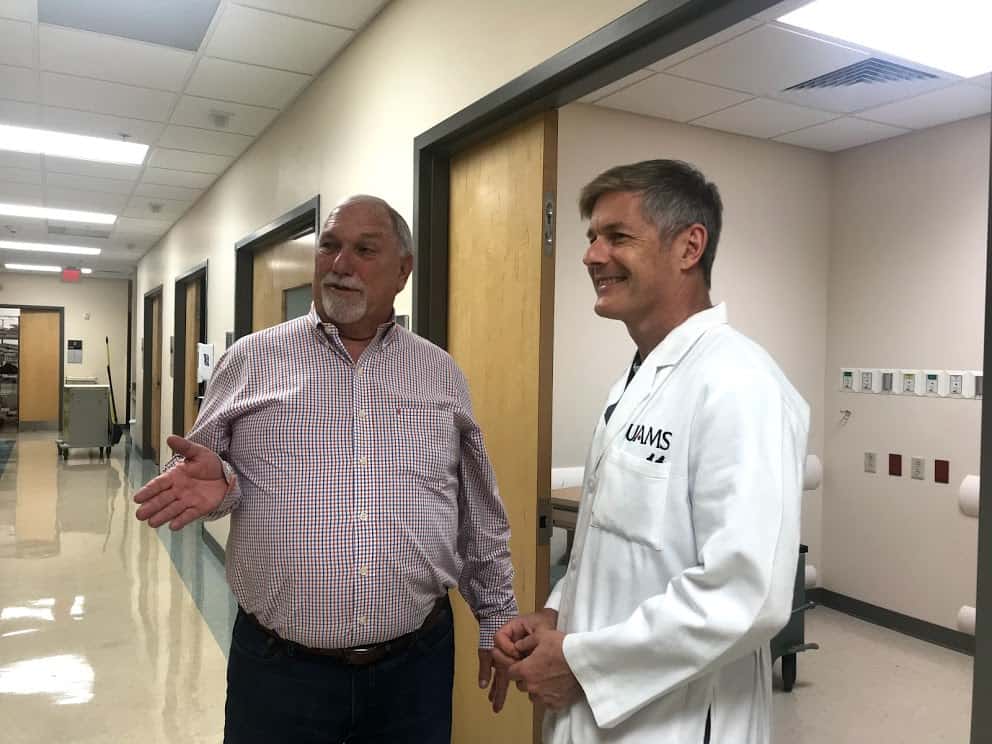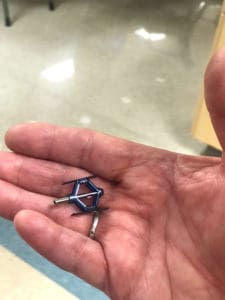View Larger Image

Raper visits Radvany at UAMS.
New Spinal Surgery Gets Pulaski County Man Back on His Feet
| Six months after a fall left him severely injured, Dewey Raper, 65, was not healing as quickly as he thought he would.
“I spent so much time in a wheelchair, a walker and on crutches,” Raper said. “Eventually, I got an MRI. Dr. Radvany viewed it and took the case over.”
Martin Radvany, M.D., is a professor and chief of interventional neuroradiology in the UAMS College of Medicine Department of Radiology. He told Raper about a new procedure that would help with his back pain and get him back to normal activities.
“The pain was so awful, I was ready to try anything to help,” Raper said. “I laid around for so long. I wasn’t able to drive or work outdoors.”
The fall happened last September. Raper was on a friend’s farm in Arkansas County preparing for the upcoming deer season.
“As I climbed a ladder to get into a tree, the ladder collapsed and I fell several feet,” Raper said.
Air medical services flew him to UAMS where health care professionals treated his injuries.
“My back still hurt several months later.”
Raper had a compression fracture on one of his vertebrae. Vertebral compression fractures
are common among older adults and can be triggered by a fall or heavy lifting. The most typically cause is osteoporosis.
Because it is not possible to stabilize the bones in the spine with a cast, the standard treatment is four to six weeks of bedrest and pain medication. That, Radvany says, is not ideal because it can lead to loss of muscle mass and a possible dependence on opioid medication.
Raper would need a procedure, called a vertebral augmentation, to stabilize the fractured vertebra and prevent other vertebra from getting compression fractures. They scheduled surgery for March.
“Multiple vertebral compression fractures can compromise a person’s ability to breathe and eat once the condition becomes severe enough,” Radvany said. “It also creates an outward curvature of the spine, resulting in a rounded upper back.”
For the vertebral augmentation, Radvany used the Spine Jack system. The device looks like a miniature replica of a car jack. Radvany inserted the flattened jack into the spine through a small hole drilled into the vertebra. Once inside, he expanded the jack to a larger size, expanding the bone. Then he filled the area inside the bone, around the jack, with bone cement to reinforce the bone. Radvany did this for two of Raper’s vertebrae.
Three months later, Raper’s wife, Cathy, says she is happy to see him back out in the yard, tending to the garden and the farm.
“I’ve noticed that even my posture is better,” Raper said. “I sit up straighter. I’m tickled to death. I could not have asked for anyone better to do my procedure. I appreciate Dr. Radvany dearly.”
UAMS is the first hospital in the state to offer the Spine Jack surgery to patients like Raper. Radvany is among the first 30 doctors in the country trained to use the device.


